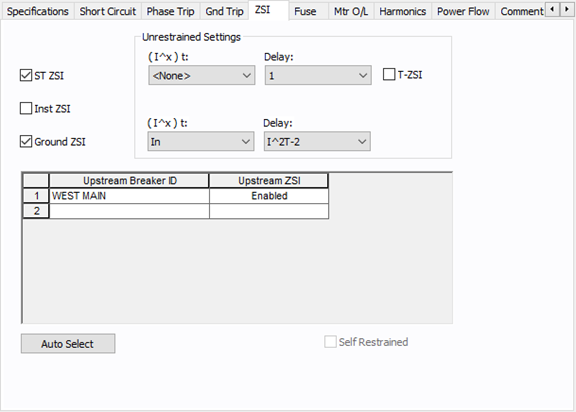LV Breaker - ZSI Tab
The ZSI tab specifies the zone selective information for LV breakers. This information is used in coordination, fault simulations and arc flash calculations. EasyPower automatically determines the fault zone for each breaker and trips only the breakers in the fault zone. The ZSI feature is available in some breakers only and is specified in the device library.
Note: Since the ZSI information depends on other breakers, it is best to fill in ZSI information only after other data has been entered.

Figure 1: ZSI Tab
| Option | Description |
|---|---|
|
ST ZSI |
Select to indicate if the Short Time Trip ZSI is set On. In analysis focus (Short Circuit, Coordination, and so on), ST ZSI can be turned “On” or “Off” temporarily using the right-click context menu. If you select this option, you can specify the (I^x)t and delay values for the unrestrained settings for the short time ZSI curve. |
|
Inst ZSI |
Select to indicate if the Instantaneous Trip ZSI is set On. In analysis focus (Short Circuit, Coordination, and so on), Inst ZSI can be turned “On” or “Off” temporarily using the right-click context menu. |
|
Ground ZSI |
Select to indicate if the Ground Trip ZSI is set On. In analysis focus (Short Circuit, Coordination, and so on), Ground ZSI can be turned “On” or “Off” temporarily using the right-click context menu. If you select this option, you can specify the (I^x)t and delay values for the unrestrained settings for the ground ZSI curve. |
|
T-ZSI |
Select to enable the T-ZSI (threshold zone selective interlocking) mode of operation. T-ZSI is a special zone selective interlocking (ZSI) feature that is available in certain trip units manufactured by GE. In this scheme, the downstream breaker can send a restraining signal to an upstream breaker at 81% of the set short time pickup or instantaneous pickup. The upstream breaker will shift its pickup to 123% when it receives a restraining. Refer to the manufacturer's documents on the details of T-ZSI operation. |
|
Upstream Breaker ID |
List of upstream breakers that receive restraining signal from this breaker. Typically, there will be one upstream breaker. All LV breakers immediately upstream, downstream or adjacent, will be available in the box. Pick the appropriate breaker. The ZSI status for the upstream breaker is indicated in the column on the right (Upstream ZSI). |
|
Upstream ZSI |
This column automatically indicates whether the ZSI is On in the breaker selected in Upstream Breaker ID column. |
|
Auto Select |
Command button to automatically list all the immediately upstream, downstream or adjacent breakers in the Upstream Breaker ID column. After choosing this button, you can delete the undesired breakers from the spreadsheet. |
|
Self Restrained |
Self-restrained breakers have the ZSI “Out” terminals jumpered to the ZSI “In” terminals so that the breaker always trips on restrained mode. Restrained mode is typically a short time delay trip. If a breaker is self-restrained, then select this check box. If a breaker is self restrained, it allows downstream breakers without ZSI to trip. At the same time, it sends a restraining signal to an upstream breaker to enable the self restrained unit to trip first (preventing the upstream breaker to trip on instantaneous). This provides selective coordination. |
More Information
- Low Voltage Breaker Data
- Database Dialog Box Toolbar
- LV Breaker - Connection Information
- LV Breaker - Specifications Tab
- LV Breaker - Short Circuit Tab
- LV Breaker - Phase Trip Tab
- Ground Trip Tab
- LV Breaker - Fuse Tab
- LV Breaker - Mtr O/L (Motor Overload) Tab
- LV Breaker - Harmonics Tab
- LV Breaker - Stability Tab
- LV Breaker - Reliability Tab
- LV Breaker - Comments Tab
- LV Breaker - Hyperlinks Tab
- LV Breaker - Collected Data Tab
- LV Breaker - Media Gallery Tab
